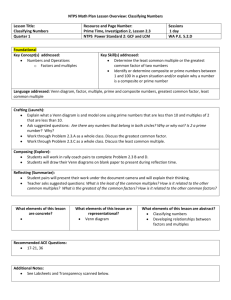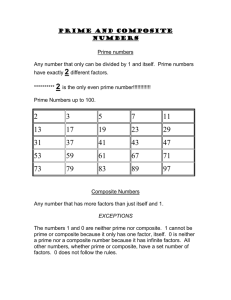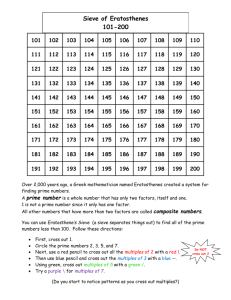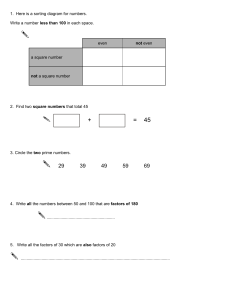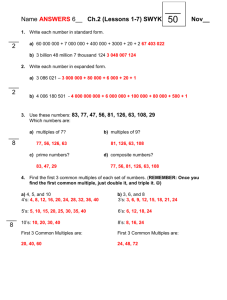Factors And Multiples
advertisement
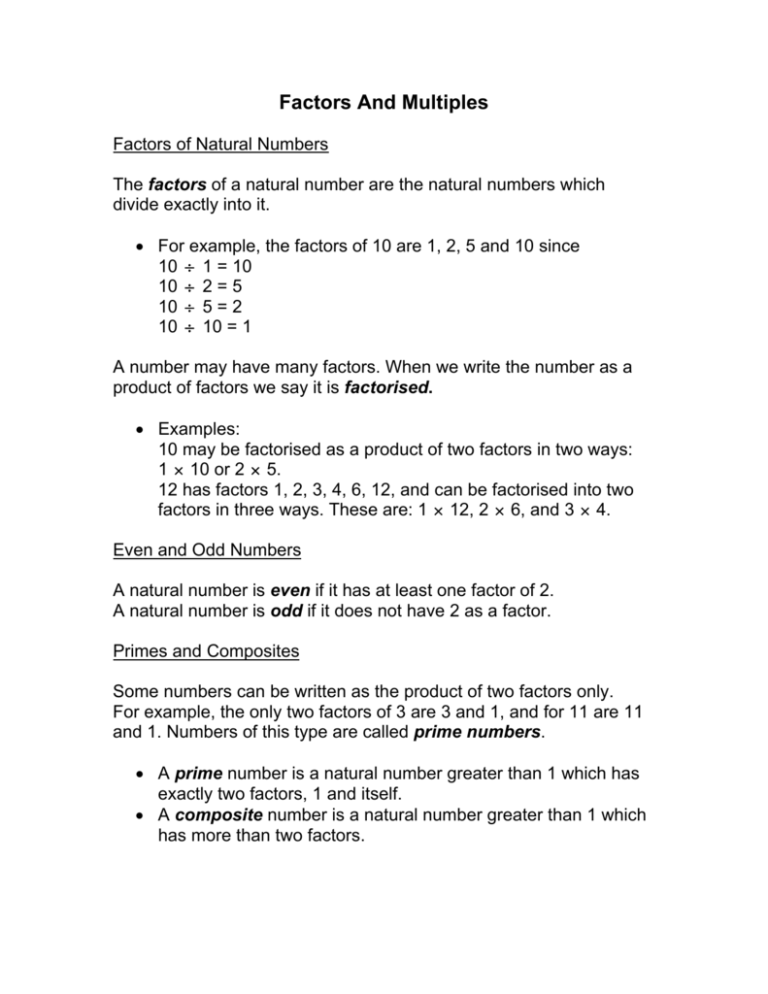
Factors And Multiples
Factors of Natural Numbers
The factors of a natural number are the natural numbers which
divide exactly into it.
• For example, the factors of 10 are 1, 2, 5 and 10 since
10 ÷ 1 = 10
10 ÷ 2 = 5
10 ÷ 5 = 2
10 ÷ 10 = 1
A number may have many factors. When we write the number as a
product of factors we say it is factorised.
• Examples:
10 may be factorised as a product of two factors in two ways:
1 × 10 or 2 × 5.
12 has factors 1, 2, 3, 4, 6, 12, and can be factorised into two
factors in three ways. These are: 1 × 12, 2 × 6, and 3 × 4.
Even and Odd Numbers
A natural number is even if it has at least one factor of 2.
A natural number is odd if it does not have 2 as a factor.
Primes and Composites
Some numbers can be written as the product of two factors only.
For example, the only two factors of 3 are 3 and 1, and for 11 are 11
and 1. Numbers of this type are called prime numbers.
• A prime number is a natural number greater than 1 which has
exactly two factors, 1 and itself.
• A composite number is a natural number greater than 1 which
has more than two factors.
From the definition of prime and composite numbers we can see that
the number 1 is neither prime nor composite.
• Example:
6 is a composite number since it has 4 factors: 1, 6, 2, 3.
Notice that one pair of factors of 6, namely 2 and 3, are both
prime numbers. In fact, all composite numbers can be written
as the product of prime number factors.
The Fundamental Theorem of Arithmetic is:
Every composite number can be written as a product of prime factors
in one and only one way (ignoring order).
• So, although 252 = 22 × 32 × 7 or 32 × 7 × 22, etc, the factors
of 252 cannot involve different prime base numbers.
Note:
If 1 was a prime number then there would not be one and only one
factorisation for each composite number.
• Example:
252 = 13 × 22 × 32 × 7 or 17 × 22 × 32 × 7, etc.
Prime Factors
To find the prime factors of a composite number we systematically
divide the number by the prime numbers which are its factors, starting
with the smallest.
• Example:
Express 252 as the product of its prime factors.
2
2
3
3
7
252
126
63
21
7
1
OR
252
0
2
126
2
0
2
63
2
0
2
21
3
0
3
2
7
Therefore, 252 = 2 × 2 × 3 × 3 × 7
{1 is not a prime factor.}
Highest Common Factor
A number which is a factor of two or more other numbers is called a
common factor of these numbers. For example, 7 is a common
factor of 28 and 35.
We can use the method of finding prime factors to find the highest
common factor (HCF) of two or more natural numbers.
• Example:
Find the highest common factor (HCF) of 18 and 24.
2
3
3
18
9
3
1
2
2
2
3
24
12
6
3
1
18 = 2 × 3 × 3
24 = 2 × 2 × 2 × 3
2 × 3 is common to both 18 and 24, and 2 × 3 = 6
Therefore, 6 is the highest common factor of 18 and 24.
Multiples of Natural Numbers
The multiples of 10 are 10, 20, 30, 40, 50, …
These are found by multiplying each of the natural numbers by 10,
i.e. 1 × 10 = 10
2 × 10 = 20
3 × 10 = 30
4 × 10 = 40
Likewise, the multiples of 15 are 15, 30, 45, 60, 75, …
The number 30 is a multiple of both 10 and 15, so we say 30 is a
common multiple of 10 and 15. Notice that 10 and 15 are both
factors of 30. In fact, 30 has several factors including 2, 3, 5, 10 and
15. 30 is a common multiple of each of its factors.
• Example:
Find common multiples of 4 and 6 between 20 and 40.
Multiples of 4 are 4, 8, 12, 16, 20, 24, 28, 32, 36, 40, …
Multiples of 6 are 6, 12, 18, 24, 30, 36, 42, …
Therefore, the common multiples between 20 and 40 are 24
and 36.
Lowest Common Multiple
The lowest common multiple (LCM) of two or more numbers is the
smallest number which has each of these numbers as a factor.
• Example:
Find the lowest common multiple of 9 and 12.
Multiples of 9 are: 9, 18, 27, 36, 45, 54, 63, 72, 81, ......
Multiples of 12 are: 12, 24, 36, 48, 60, 72, 84, ......
Therefore, the common multiples are 36, 72, ...... and 36 is the
smallest of these. So, the LCM is 36.


